|

 Up
Up 
 Pilots,
Pilots,
Planes
and Pioneers

(You are here.)
 Down
Down




  Need
to Need
to
find your
bearings?
Try
these
navigation aids:
If
this is your first
visit, please stop by:
Something
to share?
Please:



|
|
Available in Française, Español, Português, Deutsch, Россию,
中文,
日本, and others.
 hile
the Wright brothers may have been the first to make a sustained,
controlled flight, they were just two among hundreds of brave men
and women who helped to give the world its wings during the earliest
days of aviation. Their Flyer was but one of many historically
important aircraft. Below are brief descriptions and photos of some of the most important
people and planes, and where available resources and links where you can find more
information. In some cases, contributors have supplied expanded
histories and biographies. Those are listed at the right and linked below. hile
the Wright brothers may have been the first to make a sustained,
controlled flight, they were just two among hundreds of brave men
and women who helped to give the world its wings during the earliest
days of aviation. Their Flyer was but one of many historically
important aircraft. Below are brief descriptions and photos of some of the most important
people and planes, and where available resources and links where you can find more
information. In some cases, contributors have supplied expanded
histories and biographies. Those are listed at the right and linked below.
A
 B
B
 C
C
 D
D
 E
E
 F
F
 G
G
 H
H
 I
I
 J
J
 K
K
 L
L
 M
M
N
 O
O
 P
P
 Q
Q
 R
R
 S
S
 T
T
 U
U
 V
V
 W
W
 X
X
 Y
Y
 Z
Z
|
|
 |
|
|
Charles
Manly was trained in engineering at Cornell University and became
Samuel Langley's chief assistant in designing and building
Aerodrome A
or Great Aerodrome. In 1900, after waiting for New York automobile manufacturer Stephen
Balzer to deliver an acceptable engine for the Aerodrome, he
cancelled Balzer's contract and completed the engine himself, transforming
it from a disappointing 8 horsepower rotary engine to a radial developing
a whopping 52 horsepower to its 136-pound (62-kilogram) weight, making it
the most efficient and advanced motor of its day. Manly served as pilot during both attempts to
launch Aerodrome A in 1903 from a houseboat on the Potomac River,
and he took a dousing each time. Although Langley's Aerodrome was a
failure, Manly remained active in aeronautics. He was present in
Hammondsport, New York in 1908 when Glenn Curtiss won the Scientific
American Trophy for the first public flight over a kilometer in length and was a
driving force in the Aero Club of America. He worked with
Curtiss in 1914 to rebuild the Great Aerodrome and get it to
fly. From 1915 to 1920, he
worked for the Curtiss Aeroplane and Motor Corporation, first
as a consulting engineer and then as Assistant General Manager. He
was also active in the automotive industry and served as president
of the Society of Automotive Engineers in 1919. For an expanded
history of the Aerodrome A and and Manly's adventures as
its test pilot, see
The Wright/Smithsonian Controversy.
|
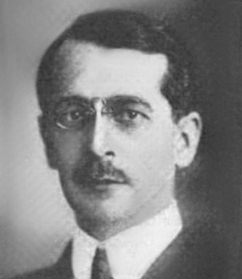
Charles Matthews Manly.
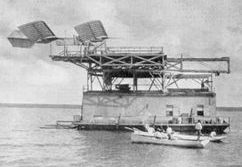
The Great Aerodrome with its
catapult cocked and ready to launch. Manly very nearly drowned
during the second crash on 8 December 1903 when his cork life vest
became entangled in the rigging. Note all the wires in the photos to
the right. To see a 3D model of the
Aerodrome, click
HERE.
|
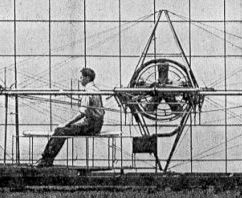
A side-view of the Great Aerodrome
airfame, showing Manly in the cockpit just ahead of his radial
engine. The cockpit nacelle in which he is seated is suspended from
the airframe like the basket of a balloon.
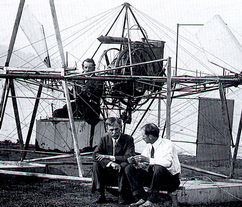
Charles Manly in the cockpit of the reconstructed
Great Aerodrome in 1914.
Albert Zahm and
Glenn Curtiss are seated at the lower right. Although
the team heavily modified the
Aerodrome to get it airborne, they used the Manly-Balzer
engine (behind Manly) for the first few flights before switching to a
more powerful Curtiss engine.
|
 |
|
Sir Hiram Maxim, in
1878, lost a priority patent battle with Thomas Edison over the
invention of the electric light. He next invented the machine gun,
found the US Department of War unreceptive, and moved to England in
1881 where the Royal Army was more convivial. In England he devoted much of his life to research in aviation but made
little substantial contribution. In his first public address on
aeronautics, Wilbur Wright credited Maxim for making the first powered
flight, although it was uncontrolled and could not be sustained. Maxim was
convinced that propulsion was the central problem in aviation and built a
lightweight steam engine that developed 180-horsepower. He mounted
two of these on a huge multi-wing airplane and tested it on a track.
The track was designed to hold the biplane down, letting it rise
only a few inches. But during one test in 1894, the track failed to
restrain the biplane and it took off with three people aboard,
careened through the air for several hundred feet, and then crashed
and was demolished. Thankfully none aboard were serious injured.
This was, as Wilbur pointed out, perhaps the first time an airplane
took off from level ground under its own power. However, owing the
lack of effective controls and a skilled pilot to man them, it could
hardly be considered a flight. Nonetheless, he had many other
successful inventions, among them the mousetrap and the bronchial
inhaler. In 1901 Queen Victoria knighted him for his contributions to
science and technology. In 1904, he designed an amusement ride to
help fund his research. Based on one of his aeronautical test rigs,
he called it the Captive Flying Machine. Today it is better known as
the Circle Swing and it's a staple at every carnival and amusement
park. Maxim built a huge (but unsuccessful) biplane in 1910 and in
1911 he partnered with the pilots
Claude Grahame-White and Louis
Bleriot to develop an airplane capable of lifting a 500-pound (227
kilogram) payload that could be used as a bomber. Ill health
prevented him from completing this project and he died in 1916. Also see:
Airmen & Chauffeurs
|
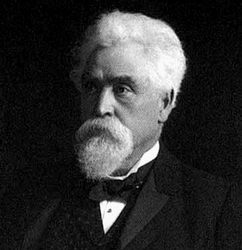
Sir Hiram Stevens Maxim was born in America in 1840, emigrated to
England in 1881, and became a naturalized British citizen in 1899.
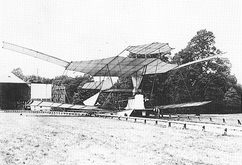
Maxim's 1893-94 "aircraft test rig" had detachable wing panels he
could add or subtract. The center section looked remarkably like the
wing of Sir George Cayley's "governable parachute."
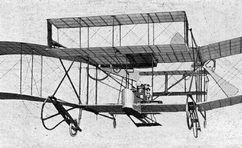
Maxim's 1910 biplane was perhaps half the size of his test rig, but
it was still an extremely large airplane for its time.
|
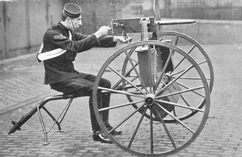
When refining his machine gun in the late 1880s, Maxim posted
notices in the local papers thoughtfully advising his neighbors to
stay inside while he tested the gun in his garden.
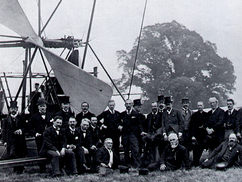
Sir Maxim (front row, middle) with friends posing in front of his
mammoth test rig before its unintended flight.
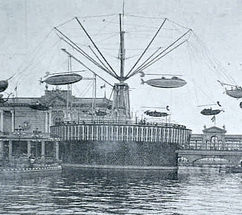
The Captive Flying Machine
(first Circle Swing), built
n 1904, is still in operation at Pleasure Beach, Blackpool, England.
|
 |
James Means of
Massachusetts was an industrialist who had given up his business and
devoted his considerable resources to the promotion of aviation. He
studied bird flight designed model gliders in 1893 and 1894. In 1895,
he published the first of three Aeronautical
Annuals, bringing together the thinking of many diverse
experimenters in the field. Means collected and edited the most
significant papers he could find on aeronautics, including the works of
Hargrave,
Lilienthal,
Chanute,
Langley, and many others. He also reprinted
some classic works by
Cayley and
Wenham. He discontinued the Annuals
after the third volume in 1897, disenchanted with the public's lack of
interest. But the three Annuals effectively summed up the state of
aeronautics in the late nineteenth century and became the springboard for
many designers of pioneer aircraft. Today, the Massachusetts Institute of
Technology – where Means was once a professor – gives out two annual
awards in his honor, one for "Flight Vehicle Engineering" and the
other for "Space Systems Engineering.
|
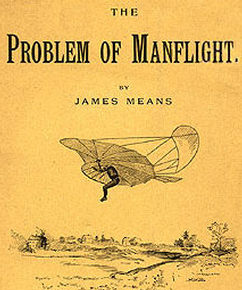
One of Means' monographs in which he outlined the obstacles to
manned flight in the late nineteenth century and described possible
methods for clearing them.
|
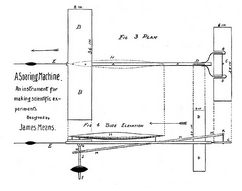
A model "soaring machine" design by James Means specifically for
aeronautical experiments.
|
 |
John
J. Montgomery of California made some of the first recorded
glider flights in America between 1883 and 1886 on the slopes of Otay
Mesa, near the California/Mexico border. Assisted by his brothers
and friends, he tested three gliders with rudimentary
aerodynamic roll and pitch controls. He gliding experiments led him
to the conclusion that he needed a better understanding of
aerodynamics and in 1885 he began a series of experiments with
various instruments to investigate how a wing produces lift. He
participated in the
International
Conference on Aerial Navigation at the World's Columbian Exhibition
at Chicago in 1893, reading a paper on "Soaring Flight." In
1903-1904, he designed a propeller for Thomas Baldwin's airship, the
California Arrow, and agreed to create a glider that could be
dropped from the airship during exhibitions. Montgomery fell out
with Baldwin, but continued the glider project with balloonist
Frank Hamilton and parachutist Daniel J. Maloney. Maloney made many
safe gliding descents from Hamilton's balloon in 1904 and 1905.
On 18 July 1905, however, the glider crashed, killing Maloney. In 1910,
Montgomery contracted with
Victor Loughhead to develop a powered flying machine. Before
he could do so, he was killed on 31 October 1911 while piloting an "improved" glider,
possibly a prototype of his planned powered aircraft.
|
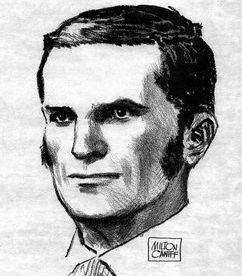
Milton Caniff made this sketch of John Joseph Montgomery when he was
inducted into the Aviation Hall of Fame in 1964.
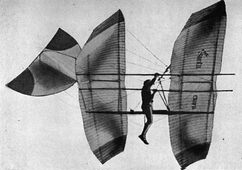
Daniel Maloney descending in Montgomery's glider after being dropped
from an altitude of approximately 500 feet (152 meters).
|
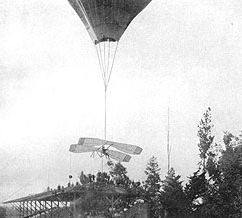
Frank Hamilton's balloon hauls Daniel Maloney aloft in Montgomery's tandem-wing
glider in 1905.
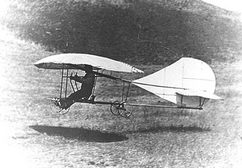
John Montgomery at the controls of the
Evergreen in 1911. He
apparently named his "improved" monoplane glider after the
California town in which he lived. The Evergreen made over 50
successful flights before the crash in which Montgomery was killed.
|
 |
Louis
Mouillard, a Frenchman living in Cairo, Egypt, began his research
in aeronautics in 1858, observing birds and building gliders. His
machines were, at best, semi-successful. He recorded a few brief
flights of under 200 feet (61 meters). Nonetheless, he learned much
from his observation and his experiments. In 1881, he wrote an
informative and passionate milestone in aeronautics, Empire of
the Air, in which he proposed fixed-wing gliders with cambered wings,
patterned after
birds. He also proposed that aviators practice in gliders to gain the skill needed to
pilot
an aircraft in the air and become experienced airmen. Up until that time, everyone in the infant field of aviation
presumed you could navigate the sky with no more skill than a chauffer.
It split the field into two camps, each with a different approach to
developing a
practical aircraft. The chauffeurs focused on engineering, making a
stable, powered flying machine.
The airmen practiced with gliders to gain skill before attempting powered flight.
|
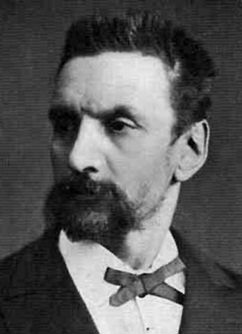
Louis Pierre-Marie Mouillard.
|
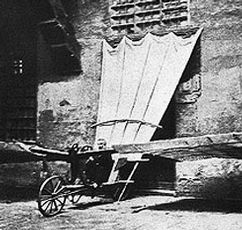
Mouillard in the cockpit of Glider
No. 4 in Cairo, Egypt, 1878.
|
 |
Alexandr
F. Mozhaisky was a captain of the Imperial Navy of Russia. In
1853 and 1854, he may have accompanied unsuccessful Russian
expeditions to the North Pole as a photographer. In the 1860s and
1870s he performed aeronautical research under the sponsorship of
the Russian military. The military discontinued his funding in 1878,
but Mozhaisky built a huge monoplane with a 74-foot (22.5 meter)
wingspan on his own nickel. In 1881, the Russian government got
interested once again and gave him 2500 rubles to purchase two steam
engines. He installed one to turn a tractor propeller at the nose of
the aircraft and the other to turn two mid-wing pusher
propellers. Mozhaisky tested his aircraft in 1884 at Krasnoye Selo, near St.
Petersburg, with I. N. Golubev in the pilot's seat. It took off down
a jump ramp and flew less than 100 feet (30 meters) before a wing
dipped and it crashed. This was the second
power-assisted take-off in history.
|
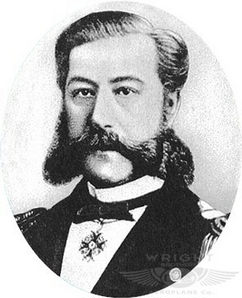
Alexandr Fyodorovich Mozhaisky.
|
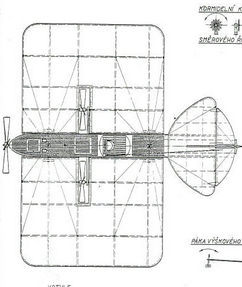
A three-view patent drawing of Mozhaisky's steam-powered airplane.
|
 |
|
|
|

